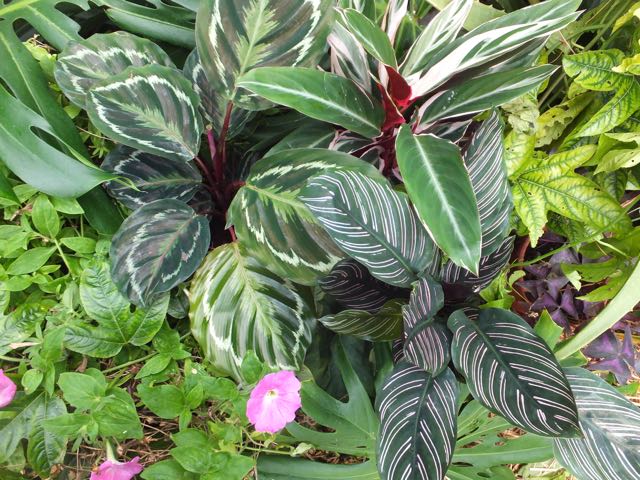
Happier as warm greenhouse specimens than as houseplants are the gorgeously flamboyant Peacock and Zebra plants, the Calatheas, from Tropical America. Oh you can force some such as C. insignis or C. zebrina to live in a well lit house but most are much happier in a warmer more humid atmosphere, it’s their tropical jungle ancestry. If they’re not warm enough they’ll sulk and an absolute minimum is 15°C/60°F. However given that warmth they crave Calatheas reward you with splendid almost carnival displays of beautifully decorated foliage for little effort.
With many possibly tens of dozens of species in the wild more than fifty have spread worldwide to almost everywhere warm enough. Even in the UK we have more than a dozen available although they are only safe growing under cover.
Calathea zebrina from the Sao Paulo region is one of the largest growing to maybe waist high but still remains a conveniently compact plant and the name aptly describes the remarkable striped leaves in shades of green with a delicious purple underneath. The original Peacock plant is C. Makoyana with a feathery pattern of short and long lines and ovals in olive green on yellowy green translucent oval leaves the pattern also seen underneath coming through a rich purplish red. C. veitchiana has similar patterning on larger more leathery and broader leaves, the pattern repeated underneath in red over blueish green.
C. ornata ‘Roseo-lineata’ has longer narrower olive green leaves patterned with purplish pink stripes which fade to white in older leaves and purple red underneath. C. rosea-picta has similar colouring on rounder leaves. The permutations are endless.
Growing from seed is possible though it’s rarely offered. Large plants are not very expensive and small specimens can be bought and grown on, more plants are obtained by simple division in the spring.
Calatheas prefer a leaf mould rich compost, warm rain water and humid conditions with light feeding in the summer. Light shade suits them. They need to be kept damp but do not like waterlogging, and in unfavourably dry conditions may suffer from red spider mites. The usual damage to foliage plants from such as snails and woodlice can become irksome if not policed otherwise though Calatheas are seldom troubled.
And there is one species with a valuable twist. C. allouia is grown in the West Indies and South America where it is known as the Guinea arrowroot or sweet corn root for it bears small tubers much like potatoes but even more delicious. It’s a shame they are so small.


